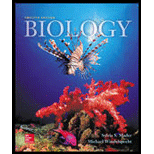
Concept explainers
To determine:
How microevolutionary changes in BMP4 and genes lead to
Introduction:
BMP4 (bone morphogenetic protein 4) is a gene that is responsible for the beak depth in the finches. On the other hand, is a gene called calmodulin that determines the length of the beaks in finches. These genes’ activity is not limited to finches only.
Explanation of Solution
Speciation happens when macroevolution happens. Macroevolution is the culmination of many small microevolutions. The causal forces behind these are selection, mutation, migration and more. The following example can illustrate how microevolutionary changes in BMP4 and genes lead to speciation in finches:
The environment of a finch population has large seeds. The finches have long and shallow beaks to feed on these. Due to dry climate, large seeds decline and small seeds increase. To consume these, the beaks must be short and deep.
Thus, the expression of BMP4 increases to deepen the beak and activity of reduces to shorten the beak. If the dry climate extents to a longer period, the gene expression modifies permanently as mentioned to produce a species of finches that have short and deep beaks to feed on small seeds. Even when the conditions turn back to normal and large seeds are available again, they will still feed on small seeds. Thus a new population has originated (speciation) via macroevolution by the accumulation small evolutionary changes in the BMP4 and genes over time.
When microevolutionary changes accumulate over time, it pulls two populations so far apart that they form new species (macroevolution).
Want to see more full solutions like this?
Chapter 17 Solutions
Biology
 Human Anatomy & Physiology (11th Edition)BiologyISBN:9780134580999Author:Elaine N. Marieb, Katja N. HoehnPublisher:PEARSON
Human Anatomy & Physiology (11th Edition)BiologyISBN:9780134580999Author:Elaine N. Marieb, Katja N. HoehnPublisher:PEARSON Biology 2eBiologyISBN:9781947172517Author:Matthew Douglas, Jung Choi, Mary Ann ClarkPublisher:OpenStax
Biology 2eBiologyISBN:9781947172517Author:Matthew Douglas, Jung Choi, Mary Ann ClarkPublisher:OpenStax Anatomy & PhysiologyBiologyISBN:9781259398629Author:McKinley, Michael P., O'loughlin, Valerie Dean, Bidle, Theresa StouterPublisher:Mcgraw Hill Education,
Anatomy & PhysiologyBiologyISBN:9781259398629Author:McKinley, Michael P., O'loughlin, Valerie Dean, Bidle, Theresa StouterPublisher:Mcgraw Hill Education, Molecular Biology of the Cell (Sixth Edition)BiologyISBN:9780815344322Author:Bruce Alberts, Alexander D. Johnson, Julian Lewis, David Morgan, Martin Raff, Keith Roberts, Peter WalterPublisher:W. W. Norton & Company
Molecular Biology of the Cell (Sixth Edition)BiologyISBN:9780815344322Author:Bruce Alberts, Alexander D. Johnson, Julian Lewis, David Morgan, Martin Raff, Keith Roberts, Peter WalterPublisher:W. W. Norton & Company Laboratory Manual For Human Anatomy & PhysiologyBiologyISBN:9781260159363Author:Martin, Terry R., Prentice-craver, CynthiaPublisher:McGraw-Hill Publishing Co.
Laboratory Manual For Human Anatomy & PhysiologyBiologyISBN:9781260159363Author:Martin, Terry R., Prentice-craver, CynthiaPublisher:McGraw-Hill Publishing Co. Inquiry Into Life (16th Edition)BiologyISBN:9781260231700Author:Sylvia S. Mader, Michael WindelspechtPublisher:McGraw Hill Education
Inquiry Into Life (16th Edition)BiologyISBN:9781260231700Author:Sylvia S. Mader, Michael WindelspechtPublisher:McGraw Hill Education





